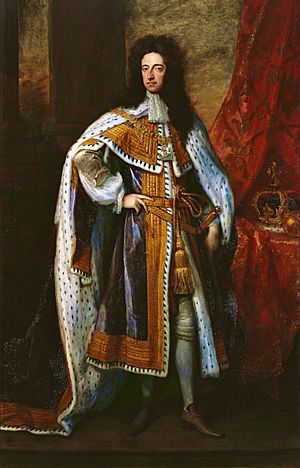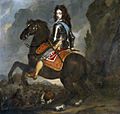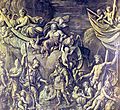William III of England facts for kids
Quick facts for kids William III |
|||||
|---|---|---|---|---|---|

Portrait by Godfrey Kneller, 1690
|
|||||
| King of England, Scotland, and Ireland (more ...) | |||||
| Reign | 1689 – 8 March 1702 | ||||
| Coronation | 11 April 1689 | ||||
| Predecessor | James II & VII | ||||
| Successor | Anne | ||||
| Co-monarch | Mary II (1689–1694) | ||||
| Stadtholder of Holland, Zeeland, Utrecht, Guelders, and Overijssel | |||||
| Reign | 4 July 1672 – 8 March 1702 | ||||
| Predecessor | William II | ||||
| Successor | Second Stadtholderless period | ||||
| Prince of Orange | |||||
| Reign | 4 November 1650 – 8 March 1702 |
||||
| Predecessor | William II | ||||
| Successor | John William Friso (titular) | ||||
| Born | 4 November 1650 [NS: 14 November 1650] Binnenhof, The Hague, Dutch Republic |
||||
| Died | 8 March 1702 (aged 51) [NS: 19 March 1702] Kensington Palace, Middlesex, Kingdom of England |
||||
| Burial | 12 April 1702 Westminster Abbey, London |
||||
| Spouse | |||||
|
|||||
| House | |||||
| Father | William II, Prince of Orange | ||||
| Mother | Mary, Princess Royal | ||||
| Religion | Protestant | ||||
| Signature |  |
||||
William III (born William Henry; 4 November 1650 – 8 March 1702) was a very important ruler in Europe. He was known as William of Orange. From the moment he was born, he was the Prince of Orange. He also became the Stadtholder (a kind of governor) of several areas in the Dutch Republic in the 1670s. Later, in 1689, he became King of England, Ireland, and Scotland. In Scotland, he was called William II.
Some people in Ireland and Scotland informally called him "King Billy." His victory at the Battle of the Boyne in 1690 is still celebrated today by some groups who wear orange colors to honor him. William ruled Britain together with his wife and cousin, Queen Mary II. Their time as rulers is often called the reign of "William and Mary."
Contents
Who Was William III?
William was the only child of William II, Prince of Orange, and Mary, Princess Royal. His mother was the daughter of King Charles I of England, Scotland, and Ireland. Sadly, William's father died just one week before William was born. This meant William became the Prince of Orange right at birth.
Marriage and Family Connections
In 1677, William married his cousin, Mary. She was the oldest daughter of his uncle, James, Duke of York. James was the younger brother of King Charles II. William was a Protestant, and he fought in several wars against the powerful King Louis XIV of France. Louis XIV was a Catholic ruler. William often joined forces with both Protestant and Catholic countries in Europe to fight against France. Many Protestants saw William as a hero who defended their faith.
The Glorious Revolution
In 1685, William's Catholic uncle and father-in-law, James, became king of England, Scotland, and Ireland. King James's rule was not popular with most people in Britain, who were Protestant. They worried that Catholicism would become too powerful again.
A group of important British political and religious leaders asked William for help. William then invaded England in an event known as the Glorious Revolution. In 1688, he landed his forces at Brixham, a port in southwest England. King James was removed from power soon after.
William and Mary's Reign
William's strong reputation as a Protestant leader helped him and his wife, Mary, take the throne. In the first few years of his rule, William was often away fighting in the Nine Years' War (1688–1697). During this time, Mary governed Britain by herself.
Challenges and Succession
Sadly, Queen Mary died in 1694. After her death, a group called the Jacobites tried to bring back the deposed King James. In 1696, they even planned to assassinate William, but their plot failed.
William and Mary did not have any children. This caused a problem for who would rule next. In 1700, William's nephew, Prince William, Duke of Gloucester, who was the son of his sister-in-law Anne, also died. This meant there was a risk to the Protestant line of succession. To solve this, a law called the Act of Settlement 1701 was passed. It made sure that distant Protestant relatives, the Hanoverians, would be next in line for the throne.
When William died in 1702, his sister-in-law Anne became queen of Britain. His cousin, John William Friso, became the titular Prince of Orange, starting a period known as the Second Stadtholderless period in the Netherlands.
Images for kids
-
William's parents, William II, Prince of Orange, and Mary, Princess Royal, 1647
-
The young prince portrayed by Jan Davidsz de Heem and Jan Vermeer van Utrecht within a flower garland filled with symbols of the House of Orange-Nassau, c. 1660
-
Johan de Witt took over William's education in 1666.
-
Recapture of Naarden by William of Orange in 1673
-
William married his first cousin, the future Queen Mary II, in 1677.
-
Portrait of William, aged 27, in the manner of Willem Wissing after a prototype by Sir Peter Lely
-
The Arrival of William III by Sir James Thornhill. William landed in England on 5 November (Guy Fawkes day), a day already special in the Protestant calendar.
-
Battle of the Boyne between James II and William III, 12 July 1690, Jan van Huchtenburg
-
Silver Crown coin, 1695. The Latin inscription is (obverse) GVLIELMVS III DEI GRA[TIA] (reverse) MAG[NAE] BR[ITANNIAE], FRA[NCIAE], ET HIB[ERNIAE] REX 1695. English: "William III, By the grace of God, King of Great Britain, France, and Ireland, 1695." The reverse shows the arms, clockwise from top, of England, Scotland, France, and Ireland, centred on William's personal arms of the House of Orange-Nassau.
-
Engraving from 1695 showing the Lord Justices who administered the kingdom while William was on campaign
-
Louis XIV of France, William's lifelong enemy
-
Statue of William III formerly located on College Green, Dublin. Erected in 1701, it was destroyed by the IRA in 1928.
-
Joint monogram of William and Mary carved onto Hampton Court Palace
See also
 In Spanish: Guillermo III de Inglaterra para niños
In Spanish: Guillermo III de Inglaterra para niños


















